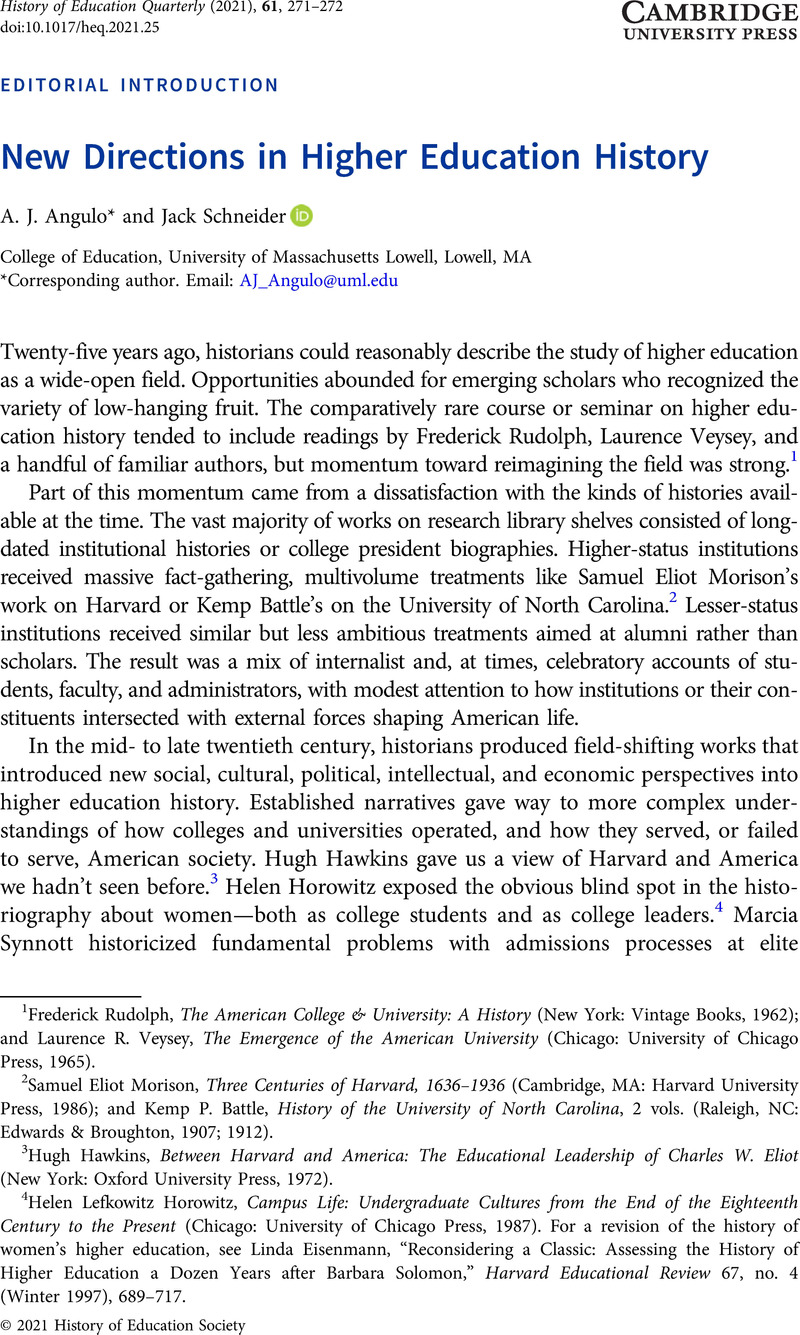No CrossRef data available.
Article contents
New Directions in Higher Education History
Published online by Cambridge University Press: 02 August 2021
Abstract

- Type
- Editorial Introduction
- Information
- Copyright
- Copyright © 2021 History of Education Society
References
1 Rudolph, Frederick, The American College & University: A History (New York: Vintage Books, 1962)Google Scholar; and Veysey, Laurence R., The Emergence of the American University (Chicago: University of Chicago Press, 1965)Google Scholar.
2 Samuel Eliot Morison, Three Centuries of Harvard, 1636–1936 (Cambridge, MA: Harvard University Press, 1986); and Kemp P. Battle, History of the University of North Carolina, 2 vols. (Raleigh, NC: Edwards & Broughton, 1907; 1912).
3 Hugh Hawkins, Between Harvard and America: The Educational Leadership of Charles W. Eliot (New York: Oxford University Press, 1972).
4 Helen Lefkowitz Horowitz, Campus Life: Undergraduate Cultures from the End of the Eighteenth Century to the Present (Chicago: University of Chicago Press, 1987). For a revision of the history of women's higher education, see Linda Eisenmann, “Reconsidering a Classic: Assessing the History of Higher Education a Dozen Years after Barbara Solomon,” Harvard Educational Review 67, no. 4 (Winter 1997), 689–717.
5 Marcia Graham Synnott, The Half-Opened Door: Discrimination and Admissions at Harvard, Yale, and Princeton, 1900–1970 (Westport, CT: Greenwood Press, 1979).
6 Steven Brint and Jerome Karabel, The Diverted Dream: Community Colleges and the Promise of Educational Opportunity in America, 1900–1985 (New York: Oxford University Press, 1989).
7 David Levering Lewis, W. E. B. Du Bois: Biography of a Race, 1868–1963 (New York: Henry Holt, 1993).
8 There are too many works to adequately source here. For a sampling, see Nash, Margaret A., ed., Women's Higher Education in the United States: New Historical Perspectives (New York: Palgrave Press, 2018)CrossRefGoogle Scholar; Williamson, Joy Ann, Black Power on Campus: The University of Illinois, 1965–75 (Champaign: University of Illinois Press, 2003)Google Scholar; Bradley, Stefan M., Upending the Ivory Tower: Civil Rights, Black Power, and the Ivy League (New York: NYU Press, 2018)Google Scholar; Groeger, Cristina, “A ‘Good Mixer’: University Placement in Corporate America,” History of Education Quarterly 58, no 1 (Feb. 2018), 33–64CrossRefGoogle Scholar; Schrum, Ethan, The Instrumental University: Education in Service of the National Agenda after World War II (Ithaca, NY: Cornell University Press, 2019)CrossRefGoogle Scholar; Jewett, Andrew, Science, Democracy, and the American University: From the Civil War to the Cold War (Cambridge, UK: Cambridge University Press, 2012)CrossRefGoogle Scholar; and Turpin, Andrea, A New Moral Vision: Gender, Religion, and the Changing Purposes of American Higher Education, 1837–1917 (Ithaca, NY: Cornell University Press, 2016)Google Scholar.




